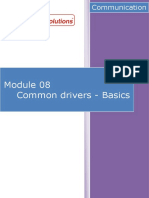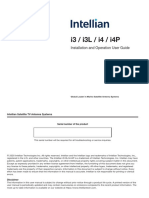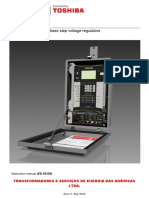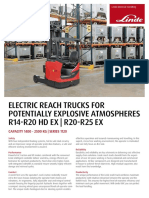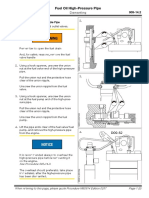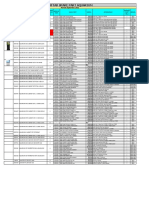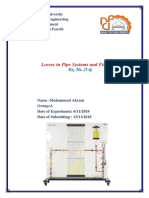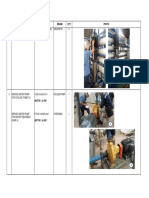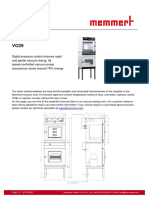TB 130 HG
TB 130 HG
Uploaded by
Hugo LeiteCopyright:
Available Formats
TB 130 HG
TB 130 HG
Uploaded by
Hugo LeiteCopyright
Available Formats
Share this document
Did you find this document useful?
Is this content inappropriate?
Copyright:
Available Formats
TB 130 HG
TB 130 HG
Uploaded by
Hugo LeiteCopyright:
Available Formats
Technical Description
HMK 130 HG
HMK 130 HG - TB / P.No. Page 1 of 11 02/2000
TABLE OF CONTENTS PAGE
1.0 CHASSIS 3
1.1 Steel Structure.................................................................................................................... 3
1.2 Propping System................................................................................................................. 3
1.3 Travel Drive......................................................................................................................... 3
1.4 Hydraulic Oil Generation for the chassis.............................................................................4
2.0 SUPERSTRUCTURE 4
2.1 Diesel Hydraulic Unit........................................................................................................... 5
2.2 Four-Rope Grab Hoisting Drive........................................................................................... 5
2.3 Slewing Gear Drive............................................................................................................. 6
2.4 Luffing Gear........................................................................................................................ 6
2.5 Counterweight..................................................................................................................... 7
3.0 TOWER / BOOM SYSTEM 7
3.1 Tower.................................................................................................................................. 7
3.2 Luffing Boom....................................................................................................................... 7
4.0 TOWER CABIN 8
4.1 Operating and Control Instruments.....................................................................................8
4.2 Fault indication.................................................................................................................... 8
5.0 LOAD CARRYING DEVICE 9
6.0 SAFETY PRECAUTIONS 9
6.1 Load Indicator / Overload Safety Device.............................................................................9
6.2 Safety Device for Crane Travelling.....................................................................................9
6.3 Propping.............................................................................................................................. 9
6.4 Limit Switches..................................................................................................................... 9
6.5 Safety Valves...................................................................................................................... 9
6.6 Windmeter......................................................................................................................... 10
6.6 Emergency Stop................................................................................................................ 10
7.0 LIGHTING 10
7.1 Operating Hours Meters.................................................................................................... 10
8.0 SURFACE PROTECTION 10
HMK 130 HG - TB / P.No. Page 2 of 11 02/2000
1.0 CHASSIS
Multi-axle chassis with wide spacing of wheel axles for optimum stability
during travelling on rubber tyres.
1.1 Steel Structure
Welded torsion resistant steel structure in box-type construction suited to
take up loads and shocks caused by crane and travel operation.
1.1.1 Transport Brackets
4 solid brackets are welded to the chassis frame to lift the fully rigged
crane.
1.1.2 Access to Chassis
Ladders provide access to the chassis from the ground.
1.2 Propping System
Four outrigger arms are perpendicularly integrated in the steel structure of
the chassis. The stabiliser pads are lowered to prop the crane and raised
hydraulically by means of a jack cylinder located in each corner.
The adjustment is carried out in the tower cab. A bubble-type levelling
device is located in the cabin to help level the crane precisely.
The hydraulic pressure for the stabilisers is generated by a hydraulic
pump located in the superstructure.
1.2.1 Stabiliser Pads
The stabiliser pads are hinged-mounted on the jack cylinders. When the
crane has to be travelled through narrow passages, they can easily be re -
moved by disconnecting only one bolt on each cylinder.
1.3 Travel Drive
The crane travels fully rigged. A hydraulic motor is flanged to the drive
axle.
1.3.1 Axles
The crane is fitted with double wheel type axles. The drive axle is
equipped with differential gears in the axle centre and planetary gears in
the wheel hubs.
HMK 130 HG - TB / P.No. Page 3 of 11 02/2000
1.3.2 Axle Suspension
The axles are mechanically suspended in equalizer systems, which allow
an individual vertical axle movement. The equalizer system distributes the
load of the total weight equally to all axles irrespective of the ground con-
ditions.
1.3.3 Steering
All steered axles are connected by tie rods so that simultaneous steering
is guaranteed. The crane is steered from the tower cab.
1.3.4 Brakes
Travel is initially braked hydraulically by means of brake valves. Further -
more hydraulically operated service brakes act on the wheel expander
devices in the non-driven axles. An additional spring-loaded parking brake
acts on one drive axle and applies automatically after the crane travel mo -
tion is stopped.
1.3.5 Travel Control
Travel is controlled from the tower cab. This includes control of travel
drive, steering, braking as well as lowering the crane from the propped po-
sition onto the rubber tyres. The crane is accelerated smoothly up to max-
imum speed in both directions.
1.3.6 Illumination under Travelling Conditions
During travelling, the following lights are in use:
• flashing alarm lamps fitted to the superstructure
1.4 Hydraulic Oil Generation for the chassis
The hydraulic oil for supply of propping, steering, travelling and braking
system is generated by a pump located on the superstructure. This pump
also generates oil pressure for the control of the luffing cylinder.
2.0 SUPERSTRUCTURE
The superstructure comprises a heavy torsion resistant steel construction
in platform design providing optimum stability to absorb all stresses
caused during operation and allowing access to all hydraulic, electrical
and mechanical equipment for maintenance purposes.
The superstructure houses the diesel-hydraulic aggregate, the hoist drive,
the slewing gear drive, the system for the luffing cylinder, the tower and
the counterweights. A stairway provides convenient access to the super-
structure.
HMK 130 HG - TB / P.No. Page 4 of 11 02/2000
In order to protect vital crane parts against the influences of the environ-
ment, the superstructure equipment is cased by galvanised sheet steels.
The sheet steels can be easily dismantled, if required, so that any of the
drive assemblies can be stripped.
2.1 Diesel Hydraulic Unit
Pressurised oil for the crane drives is provided by a diesel hydraulic unit.
The engine is equipped with starter, flywheel and connected via a prop-
shaft to the hydraulic pump distribution gear. The engine is amply dimen -
sioned so that all crane functions can be carried out simultaneously and
independently.
Power needed on the crane for illumination and control is supplied by a
generator connected directly to the diesel engine.
2.1.1 Fuel Tank
The fuel tank is integrated in the superstructure and is adequately sized
for an extensive operating period.
2.2 Four-Rope Grab Hoisting Drive
The crane is equipped with a 4-rope grab hoist unit, comprising two
identical but separate hoist units each consisting of a hydraulic motor, a
flexible coupling, a spring-loaded multiple disk brake, a fully enclosed re -
duction gear and a machine-grooved rope drum.
One hoist acts as holding winch whereas the other acts as closing hoist.
The four rope ends are connected directly to either a lifting beam (general
cargo) or a mechanical 4-rope-grab (bulk goods), i. e. hook speed equals
line speed. Two ropes are wound in one single layer on each drum so that
excessive wear is prevented.
A horizontal load path during luffing (level luffing) is possible due to the 3-
fold reeving of the hoist ropes between tower and boom head.
2.2.1 Lubrication
Splash lubrication for the gearing.
2.2.2 Hoist Brake
The hoisting motion is braked hydraulically. As soon as the hook is
brought to a near standstill a spring-loaded multiple disk brake is applied
automatically. It also acts as emergency brake in the event of a failure.
HMK 130 HG - TB / P.No. Page 5 of 11 02/2000
2.2.3 Hoist Control System
The oil for the hydraulic motor is generated by a variable displacement
pump for a most sensitive stepless speed control. The maximum possible
hoisting speed is automatically increased with reduced load.
The smooth acceleration and deceleration protects crane mechanical as
well as structural parts.
2.3 Slewing Gear Drive
The slewing gear drive in block construction consists of a hydraulic motor,
a flexible coupling with brake, fully enclosed reduction pin wheel gear
which meshes with the gear of the slew rim.
2.3.1 Lubrication
Oil bath is provided for the gearing.
2.3.2 Slewing Gear Brake
Braking of the slewing motion is primarily activated through regulating the
drive gear. A brake with two spring-loaded brake cylinders is fitted as a
parking brake.
Cylinder 1 is automatically operated as soon as the slewing motion has
come almost to a standstill to ensure smooth braking.
Cylinder 2 is automatically activated 2 – 3 seconds after slewing motion
has stopped and acts as a holding brake as well as an emergency brake.
2.3.3 Slewing Control
The oil for the hydraulic motor is generated by a variable displacement
pump for a most sensitive stepless speed control.
2.4 Luffing Gear
The boom is luffed in and out by means of a differential hydraulic cylinder,
which holds the boom in any desired position. The cylinder is mounted be -
low the boom and the boom may be lowered to the ground for mainten -
ance purposes. Brake valves control the cylinder movement. Lock valves
are provided for safety reasons.
2.4.1 Luffing Drive
The superstructure oil pressure unit consisting of a variable displacement
axial piston pump supplies pressurised oil to the luffing cylinder.
HMK 130 HG - TB / P.No. Page 6 of 11 02/2000
2.4.2 Luffing Control / Brake
The luffing motion is controlled smoothly and infinitely variably by varying
the displacement of the pumps and valves. The luffing motion is braked by
means of oil flow reduction and control valve actuation.
2.5 Counterweight
The counterweight is located at the rear of the superstructure. It is not ne-
cessary to remove the counterweight when the crane is travelled or
moved.
3.0 TOWER / BOOM SYSTEM
The tower is fixed in a nearly vertical position on the superstructure. The
high fulcrum point mounted luffing boom enables the crane to position it-
self close to the ship without endangering the ship structure.
The elevated position of the tower cabin offers an optimum view of the
working area and into the ship’s hold.
3.1 Tower
The tower comprises a welded steel structure in box and beam type
design with connecting points for boom, rope pulleys and the tower cab.
3.1.1 Rope Pulleys
A rope pulley block is provided in the tower head. The pulleys run on anti-
friction bearings and are nearly maintenance-free.
Rope guards prevent the ropes from jumping off. Access is possible by
means of a ladder.
3.2 Luffing Boom
The luffing boom comprises a welded box construction of torsion resistant
design.
3.2.1 Rope Pulleys
A rope pulley block is provided in the boom head. Material, design and
rope guards are the same as the pulley block in the tower head. The rope
pulleys are spaced apart in order to avoid undue swinging of the load.
HMK 130 HG - TB / P.No. Page 7 of 11 02/2000
4.0 TOWER CABIN
On the left-hand side of the tower, the cabin is suspended in a raised pos-
ition to provide the crane operator with optimum visibility of the ship
hatches and the working area.
The cabin is largely spaced and glazed with large safety glass windows.
The windows are arranged in such a manner that cleaning is possible.
Access to the cabin is provided by a convenient and safe stair.
Non-glazed walls of the tower cabin are insulated, panelled on the outside
with stainless steel plates and on the inside with aluminium plates lined
with hard easy-to-clean plastic.
The cabin is equipped with:
• upholstered operator seat which is adjustable in vertical
and horizontal directions
• operating and control panels
• electrical heater
• ventilator
• screen washers and wipers for front screen
• interior lighting 24 V
• bubble-type levelling device
• electric socket 24 V
• electric dual horn
• wind speed indicator
• first aid kit
• ashtray
4.1 Operating and Control Instruments
The operating and control instruments for all crane functions are located
on the control panels.
The operating instruments comprise:
Control levers and controls for all main and auxiliary crane functions and
light switches.
4.2 Fault indication
The clear text fault display unit in the tower cabin indicates electric and
physical faults during operation, e.g.:
• lack of fuel
• diesel engine malfunctions
• hydraulics malfunctions
HMK 130 HG - TB / P.No. Page 8 of 11 02/2000
• overload information
5.0 LOAD CARRYING DEVICE
The standard lifting device for general cargo consists of a traversal beam
which suspends the hook on a roller thrust bearing.
6.0 SAFETY PRECAUTIONS
The safety precautions installed are in accordance with the common regu-
lations and standards. Additional safety devices assure safe and reliable
operation.
6.1 Load Indicator / Overload Safety Device
An automatic safe load indicator ensures that the crane is operated safely
and indicates the actual load on the hook and boom current radius.
As soon as the safe working load is exceeded, hoisting up and luffing out
motions are disabled. All load reducing movements may be carried out.
6.2 Safety Device for Crane Travelling
During travelling, the superstructure and the chassis are locked mechanic-
ally.
6.3 Propping
Crane operation is disabled until the stabiliser pads are properly propped.
6.4 Limit Switches
The hoist limit switches limit the hoist and lowering motions when the
maximum and minimum hook height has been reached.
The boom limit switch switches off the luffing motion when the boom is at
the minimum or maximum boom radius respectively.
6.5 Safety Valves
The luffing cylinder and propping cylinders are equipped with safety lock
valves to ensure that the hydraulic cylinders maintain their position in the
event of pipe or flexible tube damage. Pressure limiting valves are in-
stalled in the hydraulic circuits to prevent overload.
HMK 130 HG - TB / P.No. Page 9 of 11 02/2000
6.6 Windmeter
A optional windmeter is located in the top of the tower. The wind speed is
indicated in the tower cab.
6.6 Emergency Stop
The emergency off / stop can be applied when the crane or personnel
working in the operating area of the crane are endangered.
Emergency pushbuttons are installed in the operator cabin at the super-
structure and at the chassis. If one emergency off button is pressed, all
crane motions come to a sudden stop.
All the emergency stop / off buttons can only be reset from the operator
cab.
7.0 LIGHTING
Adequate lighting is provided in the tower cabin, superstructure and on
stairways.
For night operations flood lights are suspended under the luffing jib to illu-
minate the working area.
7.1 Operating Hours Meters
The operating hours meters register the operational hours of the diesel
engine.
8.0 SURFACE PROTECTION
All load bearing parts are blast cleaned and painted to an approved spe-
cification taking into consideration the corrosive saline atmosphere in
ports.
The steel surface will be blast cleaned to preparation class 2.5.
Base paint: 2-component epoxy-resin.
Final paint: 2-component acrylic-polyurethane, high solid enamel.
Total thickness of surface protection 170 m.
HMK 130 HG - TB / P.No. Page 10 of 11 02/2000
Subject to technical modification without prior notice.
HMK 130 HG - TB / P.No. Page 11 of 11 02/2000
You might also like
- Q400.amm (76) .Amm05 11 00 992 802Document11 pagesQ400.amm (76) .Amm05 11 00 992 802Naresh Kumar5No ratings yet
- Case CX210B Mine Crawler Excavator Tier 3 Parts Manual PDFDocument701 pagesCase CX210B Mine Crawler Excavator Tier 3 Parts Manual PDFJorge Martinez100% (4)
- DCOM Configuration GuideDocument29 pagesDCOM Configuration GuideHerie HeriadieNo ratings yet
- PowerKit DieselGas 2020 Baudouin Folder Interactive 18.11.20Document7 pagesPowerKit DieselGas 2020 Baudouin Folder Interactive 18.11.20wilmer andrade bustamanteNo ratings yet
- PDF Operation and Installation Manual For e M Speed Log DownloadDocument15 pagesPDF Operation and Installation Manual For e M Speed Log DownloadMaki MakeiNo ratings yet
- Quay Walls - Combined - Wall - Buckling - TubesDocument12 pagesQuay Walls - Combined - Wall - Buckling - TubesHugo LeiteNo ratings yet
- Westen1 20p 24iDocument12 pagesWesten1 20p 24icnita77100% (1)
- AWWA M51 2001 RetypeDocument32 pagesAWWA M51 2001 Retypealan toomey100% (2)
- Technical DescriptionDocument18 pagesTechnical DescriptionHugo Leite100% (1)
- TB 60 HG-426 Bis 429 - Version - SyrienDocument60 pagesTB 60 HG-426 Bis 429 - Version - SyrienHugo Leite100% (1)
- Aruba 8360-16y2c - CoreDocument18 pagesAruba 8360-16y2c - Corejavier adrianNo ratings yet
- Quayloading HMK 90E .)Document4 pagesQuayloading HMK 90E .)Hugo Leite100% (1)
- Bypass Precharging ContactorDocument9 pagesBypass Precharging Contactoralpha1ahNo ratings yet
- LHM 800Document12 pagesLHM 800mohamed younesNo ratings yet
- February 2015 Building Automation SystemsDocument127 pagesFebruary 2015 Building Automation SystemsSantiago J. ramos jrNo ratings yet
- The Technology Behind The ExpertiseDocument21 pagesThe Technology Behind The ExpertiseDanielNo ratings yet
- Speader ppm09Document4 pagesSpeader ppm09Ngà NguyễnNo ratings yet
- Linde EN Ds t25 t30 1153 en B 0620 WebDocument6 pagesLinde EN Ds t25 t30 1153 en B 0620 WebNadeem AhmedNo ratings yet
- Fact Sheet DPR 3000B-48 EnergE IDA1 en Rev08 (W)Document2 pagesFact Sheet DPR 3000B-48 EnergE IDA1 en Rev08 (W)VIJAY VERMANo ratings yet
- In-Motion Electronic Weighbridges: Complied by Deepesh Sharma Junior Engineer (C&W) Ahmedabad Division, Western RailwayDocument39 pagesIn-Motion Electronic Weighbridges: Complied by Deepesh Sharma Junior Engineer (C&W) Ahmedabad Division, Western RailwaybvdasNo ratings yet
- Module 08 - Common Drivers - BasicsDocument36 pagesModule 08 - Common Drivers - BasicsMarious EesNo ratings yet
- 3adw000078r0301 Dcs5 Software Descr e CDocument228 pages3adw000078r0301 Dcs5 Software Descr e Caninda_dNo ratings yet
- Lap CounterDocument10 pagesLap CounterLambok MarbunNo ratings yet
- R6 Line Regen Manual - V1.3Document40 pagesR6 Line Regen Manual - V1.3Hongquan SuNo ratings yet
- Invt Servo Drive ManualDocument296 pagesInvt Servo Drive ManualAbdul HameedNo ratings yet
- 10-056-001 Four Steps To SynchronisingDocument2 pages10-056-001 Four Steps To SynchronisingangelNo ratings yet
- Curso 5 Capacitación 1921 NEMSDocument346 pagesCurso 5 Capacitación 1921 NEMSvictor figueroaNo ratings yet
- PIC101A Instruction ManualDocument2 pagesPIC101A Instruction ManualSalome BitutuNo ratings yet
- Maintenance Handbook On Block Proving by Axle Counter Using UFSBIDocument57 pagesMaintenance Handbook On Block Proving by Axle Counter Using UFSBIHarsh KumarNo ratings yet
- 86000, 86106, and 86004 Sonic Anemometers: Campbell Scientific (Canada) CorpDocument37 pages86000, 86106, and 86004 Sonic Anemometers: Campbell Scientific (Canada) Corpgenaro rodriguezNo ratings yet
- Finishing Drawing: Electro-Hydraulic Steering GearDocument50 pagesFinishing Drawing: Electro-Hydraulic Steering GearETO HtutNo ratings yet
- Final Specification For Tunnel CommunicationDocument18 pagesFinal Specification For Tunnel CommunicationRobi N DraNo ratings yet
- 85ecDocument4 pages85ecWalid MialNo ratings yet
- Technical Manual System 5000 150W FCCDocument60 pagesTechnical Manual System 5000 150W FCC'Egemen KayaNo ratings yet
- Ahlers Company BrochureDocument6 pagesAhlers Company BrochureNavnath BidgarNo ratings yet
- 1intern Report of Khuc Thanh TruongDocument40 pages1intern Report of Khuc Thanh TruongThành TrườngNo ratings yet
- Infoplc Net Profibus Control PP04 Sinamics S120 AC Drive Speed ControlDocument27 pagesInfoplc Net Profibus Control PP04 Sinamics S120 AC Drive Speed ControlIlker Yilmaz100% (1)
- Katalog Bloki Liniowe HydropressDocument149 pagesKatalog Bloki Liniowe HydropressBruno GondimNo ratings yet
- VTS Accredited Training Organizations 20210723 1Document16 pagesVTS Accredited Training Organizations 20210723 1VenusNo ratings yet
- جدول احمال 30طنDocument6 pagesجدول احمال 30طنساحرة العيونNo ratings yet
- E10.01.03.05 Full Options PDFDocument294 pagesE10.01.03.05 Full Options PDFJéssica Ferreira GonçalvesNo ratings yet
- SR Port MachineryDocument7 pagesSR Port MachineryTALHA AHMADNo ratings yet
- 01 Warranty InformationDocument22 pages01 Warranty Informationphanhiep356No ratings yet
- Autosat 2Document20 pagesAutosat 2amr salahNo ratings yet
- LP90 Fluid Application System: Customer Product Manual Part 1041182 - 04Document60 pagesLP90 Fluid Application System: Customer Product Manual Part 1041182 - 04Oussama HobbiesNo ratings yet
- I3 I3l I4 I4p User ManualDocument79 pagesI3 I3l I4 I4p User ManualsonNo ratings yet
- Ship Captain's Medical GuideDocument234 pagesShip Captain's Medical Guidenavin vargheseNo ratings yet
- Qay220v633technical SpecificationDocument23 pagesQay220v633technical Specificationhasnain abbasNo ratings yet
- Vehicle Lift Method of Statement Rev. 1Document9 pagesVehicle Lift Method of Statement Rev. 1Thomas100% (1)
- Triplex Shark Jaw and Guiding PinsDocument16 pagesTriplex Shark Jaw and Guiding PinsLuana MarchioriNo ratings yet
- Kutai ATS 22 Manual-EnDocument44 pagesKutai ATS 22 Manual-EnKawarauNo ratings yet
- Sansui Digital Weighbridge DetailsDocument11 pagesSansui Digital Weighbridge DetailsShreepad ChandolkarNo ratings yet
- Central Railway: Trouble Shooting Flow ChartsDocument125 pagesCentral Railway: Trouble Shooting Flow Chartscts kgpNo ratings yet
- IBM System x3850 X5 and x3950 X5 Installation and User's GuideDocument164 pagesIBM System x3850 X5 and x3950 X5 Installation and User's GuideMaximNo ratings yet
- IS6675 Spec For Gypsy Wheels For WindlassesDocument13 pagesIS6675 Spec For Gypsy Wheels For WindlassesAlex RotsNo ratings yet
- EWS Loudenvielle 2022 Final ResultsDocument26 pagesEWS Loudenvielle 2022 Final ResultsMattNo ratings yet
- PCMCIA Wireless LAN Card: User's ManualDocument48 pagesPCMCIA Wireless LAN Card: User's Manualrecompacted100% (1)
- Powerflex 750 Series: Stop Mode: Id: Qa32991 - Access Levels: EveryoneDocument3 pagesPowerflex 750 Series: Stop Mode: Id: Qa32991 - Access Levels: EveryoneHitesh PanigrahiNo ratings yet
- Ee-55259r6 TVC-MPDocument66 pagesEe-55259r6 TVC-MPGabriel MonteiroNo ratings yet
- MSC PoolDocument42 pagesMSC PoolFouad BoutatNo ratings yet
- Delta VFD c200 User ManualDocument363 pagesDelta VFD c200 User ManualFreund MachinesNo ratings yet
- Linde EN Ds r14 25ex br1120 en A 0718Document7 pagesLinde EN Ds r14 25ex br1120 en A 0718Nadeem AhmedNo ratings yet
- 8M21Y1100-23E200 Datasheet BaudouinDocument2 pages8M21Y1100-23E200 Datasheet BaudouinRoberto StepankowskyNo ratings yet
- TB 90 E - 09 - 03 (Englisch)Document16 pagesTB 90 E - 09 - 03 (Englisch)Hugo Leite100% (1)
- Farm Machinery - Tractors - A Collection of Articles on the Operation, Mechanics and Maintenance of TractorsFrom EverandFarm Machinery - Tractors - A Collection of Articles on the Operation, Mechanics and Maintenance of TractorsNo ratings yet
- Co Pack CANZAC 4 Page Brochure SmallDocument4 pagesCo Pack CANZAC 4 Page Brochure SmallHugo LeiteNo ratings yet
- Stat Quayload HMK130HG 44tDocument1 pageStat Quayload HMK130HG 44tHugo Leite100% (1)
- Lifting Capacity Chart: GOTTWALD Mobile Harbour Crane HMK 170 EGDocument1 pageLifting Capacity Chart: GOTTWALD Mobile Harbour Crane HMK 170 EGHugo Leite100% (1)
- New Performance Criteria For Fresh Tremie Concrete: June 2011Document9 pagesNew Performance Criteria For Fresh Tremie Concrete: June 2011Hugo LeiteNo ratings yet
- Larisch 2016 - Modern Concrete Technology & Placement Methods and Their Influence On Waterproofing Performance of Diaphragm WallsDocument11 pagesLarisch 2016 - Modern Concrete Technology & Placement Methods and Their Influence On Waterproofing Performance of Diaphragm WallsHugo LeiteNo ratings yet
- Fines Content Correction Factors For SPT N Values - LiquefactionDocument6 pagesFines Content Correction Factors For SPT N Values - LiquefactionHugo LeiteNo ratings yet
- Paper Plaxis Bulletin Floris BesselingDocument8 pagesPaper Plaxis Bulletin Floris BesselingHugo LeiteNo ratings yet
- Roller-Compacted Concrete For Ports PDFDocument2 pagesRoller-Compacted Concrete For Ports PDFHugo LeiteNo ratings yet
- NM CataloguesDocument6 pagesNM Cataloguessuinpe100% (1)
- Intake StructuresDocument25 pagesIntake StructuresSalabha TG100% (1)
- Man B&W: Fuel Oil High-Pressure PipeDocument5 pagesMan B&W: Fuel Oil High-Pressure PipeJr Bulog WadayNo ratings yet
- Design Construction and Evaluation of A Hydraulic Oil FiltratioDocument58 pagesDesign Construction and Evaluation of A Hydraulic Oil FiltratioAbhishek ChaudhariNo ratings yet
- BV Class CertifcateDocument2 pagesBV Class CertifcateShanish JobNo ratings yet
- Stern SSH Catalogo Serie Handpumps Completo - 1 - OriginalDocument6 pagesStern SSH Catalogo Serie Handpumps Completo - 1 - OriginalEbrahim AhmariNo ratings yet
- KAFCO Exam 2021Document2 pagesKAFCO Exam 2021Abirul Haque67% (3)
- Ee Eipc3 5.englDocument10 pagesEe Eipc3 5.englZoran JankovNo ratings yet
- Fmds 0213Document3 pagesFmds 0213Vyto BabrauskasNo ratings yet
- Tce Consulting Engineers Limited Design Guide For Line SizingDocument27 pagesTce Consulting Engineers Limited Design Guide For Line SizingKaliya PerumalNo ratings yet
- Service Manual: Electrical Forklift TruckDocument38 pagesService Manual: Electrical Forklift TruckДмитро Селютин100% (1)
- ACS480 Catalog 3AUA0000204668 RevF EN 15-9-2021 LowresDocument40 pagesACS480 Catalog 3AUA0000204668 RevF EN 15-9-2021 LowresNeryNo ratings yet
- 01 IntroductionDocument5 pages01 Introductionnugraha kurniawanNo ratings yet
- Ecr145c Eu EngDocument20 pagesEcr145c Eu Engdalibor_bogdan100% (2)
- GEA33306 BN Hydro Application Guide - R7Document48 pagesGEA33306 BN Hydro Application Guide - R7Viet DinhTrongNo ratings yet
- Oriental Engineering Works PVTDocument8 pagesOriental Engineering Works PVTDarshan DhimanNo ratings yet
- 25vq21 PartsDocument4 pages25vq21 PartsAlaa saidNo ratings yet
- List Part Aquarium Store Mei 2022Document5 pagesList Part Aquarium Store Mei 2022rio asmitoNo ratings yet
- Losses in Pipe Systems and FittingsDocument15 pagesLosses in Pipe Systems and FittingsMUHAMMAD AKRAMNo ratings yet
- Boiler Feed PumpDocument12 pagesBoiler Feed PumpFirdaus Syifaan PratamaNo ratings yet
- 23 11 13 Facility Fuel-Oil Piping PDFDocument25 pages23 11 13 Facility Fuel-Oil Piping PDFHaidarSedayuNo ratings yet
- Manual Foundry Master PRO Rev. 0710Document174 pagesManual Foundry Master PRO Rev. 0710Edilson Nunes PollnowNo ratings yet
- Various Pump AFDocument5 pagesVarious Pump AFaleyateknikindonesiaNo ratings yet
- ME8694 Hydraulics and PneumaticsDocument79 pagesME8694 Hydraulics and PneumaticselabalajiNo ratings yet
- ASME Change of StandardsDocument6 pagesASME Change of Standardss_omeone4usNo ratings yet
- Memmert - Vacuum Oven VO29Document4 pagesMemmert - Vacuum Oven VO29Indah Nur FadhilahNo ratings yet




















